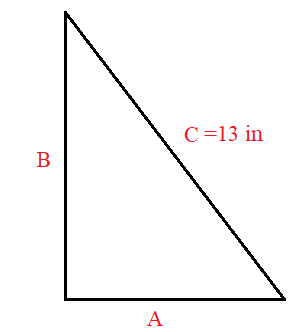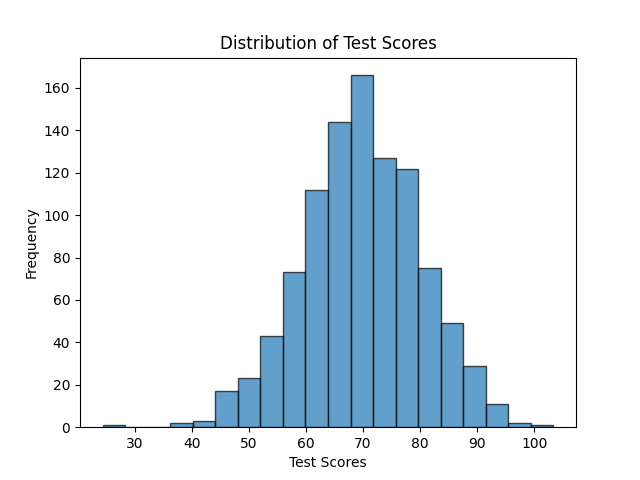A farmer needs to buy fertilizer for his farmland. The instructions on the bag of the fertilizer say 49.5 pounds of fertilizer is needed for 1 acre of land. The farmer buys 2,000 pounds of fertilizer. Which of the following is the approximate number of acres he can cover with the fertilizer he bought?
A. 40
B. 120
C. 300
D. 1000
From the given problem,
49.5 pounds of fertilizer is needed to farm 1 acre of land. This can be interpreted as:

Or

Now we are needed to find the acres of land that will be farmed using 2000 pounds of fertilizers. To solve this, we use the second option as follows:

2000 pounds of fertilizers can farm approximately 40 acres of land.
Therefore, the Correct Answer is A.
More Questions on TEAS 7 Math
-
Q #1: A pudding recipe for 50 people calls for 4 cups of sugar. Each bag of sugar contains 6 cups. How many bags of sugar will be needed to make this recipe for 300 people?
A. 8 bags
B. 13 bags
C. 4 bags
D. 24 bags
Answer Explanation
We need to perform a series of numerical dimensional analysis to find the number of bags sugar needed for 300 people.
We are told that 50 people need 4 cups of sugar. This can be interpretated as:

Or

Also, one bag of sugar contains 6 cups. This can also be presented as:

Or

We use the second option relating number of people and cups, and second option relating cups of sugar and bag of sugar to find for number of bags of sugar needed for 300 people.

Therefore, 300 people will need 4 bags of sugar.
-
Q #2: The hypotenuse (side C) of a triangle is 13 inches long. Which of the following pairs of measurements could be the correct for the lengths of the other two sides of the triangle? (Note: A2 + B2= C2)
A. 5 inches, 12 inches
B. 2.5 inches, 6 inches
C. 2.5 inches, 4 inches
D. 5 inches, 8 inches
Answer Explanation
In this problem, we take the triangle as a right-angled triangle and label it as follows:

From the Pythagoras theorem A2 + B2= C2, we can look for a combination of A and B that when the squares of A and B are summed give a square of 13. Mathematically,

But C=13 inches


If we take A=5 inches and B=12 inches, then



Next, we take A=2.5 inches, B=6 inches



Next, we take A=2.5 inches, B=4 inches

6.25+16=169

22.25≠169

Taking A=5 inches and B=8 inches



From the above computation, the combination of A=5 inches and B=12 inches give a triangle with a hypothenuse of 13 inches.
-
Q #3: A teacher has asked all the students in the class which days of the week they get up after 8 a.m. Which of the following is the best way to display the frequency for each day of the week?
A. Pie graph
B. Bar graph
C. Histogram
D. Scatterplot
Answer Explanation
The best way to display the frequency of each day of the week when students get up after 8 a.m. is by using a bar graph. Bar graphs are well-suited for representing categorical data, where each day of the week is a separate category, and the height of each bar corresponds to the count or frequency of students waking up late on that specific day.
Note: Histograms, on the other hand, are more appropriate for visualizing continuous or numerical data and are not ideal for categorical data like days of the week. Histograms are useful for understanding the distribution of data, identifying patterns, and assessing the shape of the data distribution, such as whether it's normally distributed, skewed, or has multiple modes.
As you can see below, the Histogram is used to depict a pattern/continuous data. While a bar graph does just fine even with discrete data.


-
Q #4: A patient drives 19 miles one way to a medical facility for treatment. How far does the patient drive round-trip in 22 days of treatment?
A. 1,254 miles
B. 1,672 miles
C. 418 miles
D. 836 miles
Answer Explanation
Round trip means to and from, which is twice the distance from home to a medical facility.
In one day, the round trip=19+19=38 miles
So, in 22 days, the round trip=38*22=836 miles.
The patient will cover 836 miles in 22 days.
-
Q #5: To rent tablecloth from a rental vendor, there is an initial charge of $40. There is an additional charge of $5 per circular tablecloth (c) and $3.50 per rectangular tablecloth (r). Which of the following represents the total cost (T) to rent tablecloths?
A. 5r + 3.5c - 40 = T
B. 5c + 3.5r + 40 = T
C. 5c + 3.5r - 40 = T
D. 5r + 3.5c + 40 = T
Answer Explanation
From the given scenario:
Initial charge is $40
Additional charge per circular cloth=$5c
Additional charge per rectangular cloth=$3.50r
Total cost = additional charge per circular rectangular cloths + Initial charge
Total cost, T = 5c + 3.5r + 40
-
Q #6: Using the numbers below, which of the following is the greatest? 4/3, 27/20, 1.369, 1.357
A. 1.369
B. 4/3
C. 27/20
D. 1.357
Answer Explanation
to do a comparison of the given data set, we convert the fraction numbers into the approximate decimals.
4/3=1.333
2720=1.35
Now, we have 1.333, 1.35, 1.369, 1.357. These numbers are arranged from the smallest to the largest number, we look at the number in the second decimal place value
1.333 the number in second decimal place value is 3
1.35 the number in third decimal place value is 5
1.369 the number in third decimal place value is 6
1.357 the number in third decimal place value is 5
However, 1.35 and 1.357 have 5 in the second-place vale. We use the ird place value to compare the two number:
1.35 is same as 1.350 and the number in the third-place value is 0
1.357 the number in the third-place value is 7
Now, 0 is less than 7, and thus 1.35 is less than 1.357
Overall, 3 is less than 5, and 5 less than 6 and the provided numbers can be arranged from the smallest to the largest as:
1.333, 1.35, 1.357, 1.369
Thus, the corresponding given numbers organized from the smallest to the largest become:
4/3, 27/20, 1.357, 1.369
The greatest value is 1.369
-
Q #7: Simplify the expression below. Which of the following is correct? \(18x^5yz\ \div\ \ 6xyz^4\)
A. \(3x^4z^3\)
B. \(3x^4yz^3\)
C. \(\frac{(3x)^4}{z^3}\)
D. \(\frac{(3x^4)}{z^3}\)
Answer Explanation
We use the properties of exponent with the same base to solve for above expression.
Multiplication of exponents with same base, we add the exponents

Division of exponents with same base, we subtract the exponents

Using these two properties, we can solve the expression:


Now we use the following properties:
y0 =1, and
 , thus
, thus
-
Q #8: A recipe calls for 2.5 teaspoons of vanilla, 1 teaspoon equals approximately 4.93 mL. Which of the following is the correct amount of vanilla in mL?
A. 12.325 mL
B. 5.32 mL
C. 7.43 mL
D. 0.507 mL
Answer Explanation
We are given that 1 teaspoon=4.93 mL, we can interpret it as:

Or

Since we are to find the amount in mL, we look for an option that will cancel teaspoon and remain with mL. The second option is the required conversion, and we proceed as follows:

Therefore, 2.5 teaspoons hold about 12.325 mL.
-
Q #9: Four hundred milligrams is equal to how many grams?
A. 4 g
B. 0.4 g
C. 400,000 g
D. 0.00004 g
Answer Explanation
we are asked to change 400 mg to g. We use the conversion 1g=1000mg, which we can write as:

So, 400 mg to g becomes

-
Q #10: Which of the following is the value of x in the equation below? 4x- 3- 5x=24
A. -27
B. -6
C. 3
D. 21
Answer Explanation
to solve for x, we order like terms together and proceed as follows:
4x-3-5x=24
Add 3 to both sides of the equation
4x-3+3-5x=24+3
4x+3-3-5x=27
4x-5x=27
-x=27
Divide both sides by -1
-x/-1=27/-1
x= -27
Thus, the unknown value of x is -27
Free Access on TEAS 7 Exams and Study Notes
- Access to all TEAS 7 Exams
- Performance Tracking and Analysis
- Well Documented and Explained Questions and Answers
- 2000+ Questions and Correct Answers: Answers Well Explained
- Libary of Detailed StudyNotes
- Topical Questions and Answers on Examinable topics
TEAS 7 Exams (Q&A)
TEAS 7 Study Notes
TEAS 7 Topical Tests

TEAS 7 Study Guides
Quick Links
Refer a Friend
Refer a friend and claim free unlimited access

© 2024 ExamGates Made with by ExamGates
